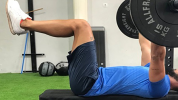bluejeff
Level 7 Valued Member
This was my tom-ay-to tom-ah-to reference.Are y’all considering retracting shoulder blades or lifting your chest to be arching your back?
This, as you say, is a big difference. I would posit, however ,that the position of the shoulder blades between the former and latter is pretty much the same. The "powerlifting arch" doesn't, from what I can tell, change the position of the scaps that much. That is, the relative position of the scaps in "just retracting the scaps" vs a "huge powerlifting arch" is not going to be that different. Arching the back/spine more isn't going to add extra retraction. It will change the angle of the press, however. All I was getting at was that retracting the scaps vs lifting the chest is going to be pretty much the same thing. Adding in pushing with the feet and hips is an extra element.There’s a HUGE difference in benching with feet on the floor and a big “powerlifting” arch versus just tucking the shoulders.
Then again, I also think (and this is my fault) that we are perhaps getting a little too nitpicky, maybe?


